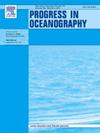观测误差似乎可以解释大西洋鳕鱼在工业化捕捞后早熟的现象
IF 3.6
3区 地球科学
Q1 OCEANOGRAPHY
引用次数: 0
摘要
估算产卵种群生物量(SSB)需要成熟度数据,这是设定配额最常用的依据。这些数据在研究鱼类对诸如生物物理变异和渔业引起的进化的反应时也很重要。数据最丰富的大西洋鳕鱼(Gadus morhua)种群(≥40-50 年)的官方成熟时间序列显示了年龄在50岁时突然下降 %-成熟度(A50)的窗口。在这里,我们讨论了东北北极(NEAC)和北海(NSC) cod时间序列的这些变化是否是由采样修正引起的人工产物。在互补的生态生理学方法中,分析扩展到其他鳕鱼种群,包括北方鳕鱼(NC)。对开放获取的NEAC和NSC数据库的质量评估表明,A50的突变与改变的采样一致,而不是源于生物学。特别长的新非洲经济区商业捕捞系列并没有显示出选择性清除作为因果机制的证据。高种群年龄多样性与特定年龄产卵时间的协同作用和采样覆盖率不足增加了偏差高A50的风险。我们发现75年NEAC A50序列无显著变化(p值 = 0.576),而44年NSC A50序列有显著变化(p值 = 0.041)。组织学强化了NEAC A50的变异性比通常所说的要小。经修订的《新非洲经济咨委会A50》大大提高了历史SSB,对征聘动态模式和渔业(生物)参考点产生了影响。从本质上讲,各种鳕鱼种群都符合相同的成熟可塑性方案,这表明性成熟的决定是由温度依赖的身体生长速度控制的。本文章由计算机程序翻译,如有差异,请以英文原文为准。
Observation error appears to explain the perception of earlier maturation in Atlantic cod following the industrialised fishing
Maturity data are required to estimate spawning stock biomass (SSB) which is the most common basis for setting quota. Such data are also important when studying stock responses to, for instance, biophysical variability and fisheries-induced evolution. The official maturity time series of the most data-rich Atlantic cod (Gadus morhua) stocks (≥40-50 years) display windows of sudden reductions in age-at-50 %-maturity (A50). Here, we addressed whether these shifts in Northeast Arctic (NEAC) and North Sea (NSC) cod time series are artefacts caused by revisions to sampling. In the complementary ecophysiological approach, the analysis was extended to other cod stocks, including Northern cod (NC). The quality-assessment of the open-access NEAC and NSC databases clarified that the abrupt shifts in A50 coincide with altered sampling rather than being rooted in biology. The exceptionally long NEAC commercial catch series did not show evidence of selective removal as a causal mechanism. A high stock age diversity in synergy with age-specific spawning time and inadequate sampling coverage heighten the risk for biased high A50. We found no significant change in the 75-year NEAC A50 series (p-value = 0.576), but so in the 44-year NSC A50 series (p-value = 0.041). Histology strengthened that NEAC A50 is less variable than frequently stated. The revised NEAC A50 led to significantly higher historic SSB, with consequences for recruitment dynamics patterns and fisheries (biological) reference points. Essentially, the various cod stocks fitted into the same maturation plasticity scheme suggested that the decision to sexually mature is steered by temperature-dependent body growth rate.
求助全文
通过发布文献求助,成功后即可免费获取论文全文。
去求助
来源期刊

Progress in Oceanography
地学-海洋学
CiteScore
7.20
自引率
4.90%
发文量
138
审稿时长
3 months
期刊介绍:
Progress in Oceanography publishes the longer, more comprehensive papers that most oceanographers feel are necessary, on occasion, to do justice to their work. Contributions are generally either a review of an aspect of oceanography or a treatise on an expanding oceanographic subject. The articles cover the entire spectrum of disciplines within the science of oceanography. Occasionally volumes are devoted to collections of papers and conference proceedings of exceptional interest. Essential reading for all oceanographers.
 求助内容:
求助内容: 应助结果提醒方式:
应助结果提醒方式:


